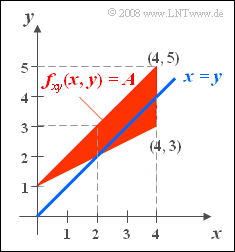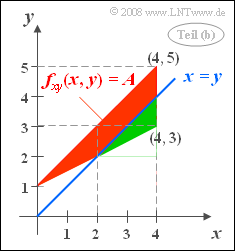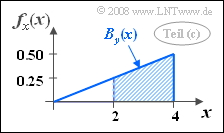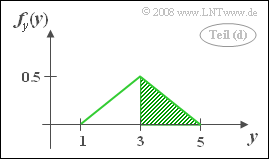Difference between revisions of "Aufgaben:Exercise 4.1: Triangular (x, y) Area"
| (2 intermediate revisions by 2 users not shown) | |||
| Line 3: | Line 3: | ||
}} | }} | ||
| − | [[File:P_ID172__Sto_A_4_1.png|right|frame|Triangular | + | [[File:P_ID172__Sto_A_4_1.png|right|frame|Triangular two-dimensional area]] |
| − | A | + | A two-dimensional random variable is defined by the adjacent sketch: |
| − | * | + | *For $(x, \ y)$ only values within the triangular-shaped region defined by the three vertices $(0,\ 1)$,$ $(4,\ 3)$,$ and $(4,\ 5)$ can occur. |
| − | *Within the triangle, all the random variables $(x,\ y)$ are equally probable. | + | *Within the triangle, all the random variables $(x,\ y)$ are equally probable. |
| − | *For the 2D– | + | *For the 2D–PDF, in this domain: |
:$$f_{xy}(x,y) = A .$$ | :$$f_{xy}(x,y) = A .$$ | ||
| − | In addition, the straight line $x = y$ ⇒ "angle bisector" is drawn in the | + | In addition, the straight line $x = y$ ⇒ "angle bisector" is drawn in the graphic ⇒ see subtask '''(2)'''. |
| Line 17: | Line 17: | ||
| − | + | Hint: | |
| − | |||
| − | |||
*The exercise belongs to the chapter [[Theory_of_Stochastic_Signals/Two-Dimensional_Random_Variables|Two-Dimensional Random Variables]]. | *The exercise belongs to the chapter [[Theory_of_Stochastic_Signals/Two-Dimensional_Random_Variables|Two-Dimensional Random Variables]]. | ||
| Line 32: | Line 30: | ||
| − | {Calculate the probability that $x$ is greater than $y$ | + | {Calculate the probability that $x$ is greater than $y$. |
|type="{}"} | |type="{}"} | ||
${\rm Pr}(x > y) \ = \ $ { 0.25 3% } | ${\rm Pr}(x > y) \ = \ $ { 0.25 3% } | ||
| − | {Determine the marginal PDF $f_x(x)$. Calculate the probability that $x$ is greater than or equal to $2$ | + | {Determine the marginal PDF $f_x(x)$. Calculate the probability that $x$ is greater than or equal to $2$. <br>Check the value with the 2D–PDF. |
|type="{}"} | |type="{}"} | ||
${\rm Pr}(x ≥ 2)\ = \ $ { 0.75 3% } | ${\rm Pr}(x ≥ 2)\ = \ $ { 0.75 3% } | ||
| − | {Determine the marginal PDF $f_y(y)$. Calculate the probability that $y$ is greater than or equal to $3$ | + | {Determine the marginal PDF $f_y(y)$. Calculate the probability that $y$ is greater than or equal to $3$. <br>Check the value with the 2D–PDF. |
|type="{}"} | |type="{}"} | ||
${\rm Pr}(y ≥ 3)\ = \ $ { 0.5 3% } | ${\rm Pr}(y ≥ 3)\ = \ $ { 0.5 3% } | ||
| − | {What is the probability that the random variable | + | {What is the probability that the random variable $x$ is greater than or equal to $2$ and at the same time the random variable $y$ is greater than or equal to $3$? |
|type="{}"} | |type="{}"} | ||
${\rm Pr}\big[(x ≥ 2) ∩ (y ≥ 3)\big]\ = \ $ { 0.5 3% } | ${\rm Pr}\big[(x ≥ 2) ∩ (y ≥ 3)\big]\ = \ $ { 0.5 3% } | ||
| Line 66: | Line 64: | ||
{{ML-Kopf}} | {{ML-Kopf}} | ||
'''(1)''' The volume under the two dimensional PDF is by definition equal to $1$: | '''(1)''' The volume under the two dimensional PDF is by definition equal to $1$: | ||
| − | [[File:P_ID219__Sto_A_4_1_b.png|right|frame|Triangular 2D PDF]] | + | [[File:P_ID219__Sto_A_4_1_b.png|right|frame|Triangular 2D–PDF]] |
:$$\int_{-\infty}^{+\infty}\int_{-\infty}^{+\infty}f_{xy}(x,y)\, {\rm d}x\, {\rm d}y=1.$$ | :$$\int_{-\infty}^{+\infty}\int_{-\infty}^{+\infty}f_{xy}(x,y)\, {\rm d}x\, {\rm d}y=1.$$ | ||
*The triangle area is $D = 0.5 \cdot 2 \cdot 4 = 4$. | *The triangle area is $D = 0.5 \cdot 2 \cdot 4 = 4$. | ||
| − | *Since in this definition area the PDF is constantly equal to $A$ | + | *Since in this definition area the PDF is constantly equal to $A$, we get. |
:$$A= 1/D\hspace{0.15cm}\underline{= 0.25}.$$ | :$$A= 1/D\hspace{0.15cm}\underline{= 0.25}.$$ | ||
| Line 76: | Line 74: | ||
'''(2)''' For the solution we start from the adjacent sketch. | '''(2)''' For the solution we start from the adjacent sketch. | ||
*The area $x>y$ lies to the right of the angle bisector $x=y$ and is marked in green. | *The area $x>y$ lies to the right of the angle bisector $x=y$ and is marked in green. | ||
| − | |||
*This green triangular area is $D_{\rm (2)} = 0.5 \cdot 1 \cdot 2 = 1 $, i.e. exactly one quarter of the total area $D$ of the definition area. | *This green triangular area is $D_{\rm (2)} = 0.5 \cdot 1 \cdot 2 = 1 $, i.e. exactly one quarter of the total area $D$ of the definition area. | ||
*From this follows ${\rm Pr}(x > y)\hspace{0.15cm}\underline{= 0.25}$. | *From this follows ${\rm Pr}(x > y)\hspace{0.15cm}\underline{= 0.25}$. | ||
| Line 83: | Line 80: | ||
'''(3)''' For the wanted marginal PDF holds in this case: | '''(3)''' For the wanted marginal PDF holds in this case: | ||
| − | [[File:P_ID220__Sto_A_4_1_c.png|right|frame| | + | [[File:P_ID220__Sto_A_4_1_c.png|right|frame|Marginal PDF with respect to $x$]] |
:$$f_x(x)=\int_{-\infty}^{+\infty}f_{xy}(x,y)\, {\rm d}y=A\cdot B_y (x).$$ | :$$f_x(x)=\int_{-\infty}^{+\infty}f_{xy}(x,y)\, {\rm d}y=A\cdot B_y (x).$$ | ||
| Line 92: | Line 89: | ||
:$$\rm Pr(\it x\ge \rm 2) = \rm 1-\rm Pr(\it x < \rm 2) = \rm 1-\frac{1}{2}\cdot2\cdot 0.25\hspace{0.15cm}\underline{ =0.75}. $$ | :$$\rm Pr(\it x\ge \rm 2) = \rm 1-\rm Pr(\it x < \rm 2) = \rm 1-\frac{1}{2}\cdot2\cdot 0.25\hspace{0.15cm}\underline{ =0.75}. $$ | ||
| − | *The same result is obtained using 2D PDF: To the right of $x = 2$ lies $3/4$ of the total definition area. | + | *The same result is obtained using 2D–PDF: To the right of $x = 2$ lies $3/4$ of the total definition area. |
<br clear=all> | <br clear=all> | ||
| − | [[File:P_ID221__Sto_A_4_1_d.png|right|frame| | + | [[File:P_ID221__Sto_A_4_1_d.png|right|frame|Marginal PDF with respect to $y$]] |
| − | '''(4)''' Analogous to the | + | '''(4)''' Analogous to the solution of the subtask '''(3)''' holds: |
:$$f_y(y)=\int_{-\infty}^{+\infty}f_{xy}(x,y)\, {\rm d}x=A\cdot B_x (y).$$ | :$$f_y(y)=\int_{-\infty}^{+\infty}f_{xy}(x,y)\, {\rm d}x=A\cdot B_x (y).$$ | ||
| − | *The | + | *The width of PDF area in $x$–direction is zero for $y \le 1$ and $y \ge 5$ respectively. |
*The maximum is at $y=3$ and gives $B_x(y=3) = 2$. | *The maximum is at $y=3$ and gives $B_x(y=3) = 2$. | ||
| − | *In between, the increase and decrease of $B_x(y)$ is linear, yielding a triangular-shaped PDF. | + | *In between, the increase and decrease of $B_x(y)$ is linear, yielding a triangular-shaped PDF. |
| − | *The probability that $y | + | *The probability that $y=3$ corresponds to the green shaded area in the adjacent sketch. |
| − | * Because of the symmetry, one obtains: | + | * Because of the symmetry, one obtains: |
:$${\rm Pr}(y ≥ 3)\hspace{0.15cm}\underline{ =0.5}. $$ | :$${\rm Pr}(y ≥ 3)\hspace{0.15cm}\underline{ =0.5}. $$ | ||
| − | The same result is obtained using 2D PDF: Above the horizontal $y= 3$ lies half of the total definition area. | + | The same result is obtained using 2D–PDF: Above the horizontal $y= 3$ lies half of the total definition area. |
[[File:P_ID222__Sto_A_4_1_e.png|right|frame|On subtask '''(5)''']] | [[File:P_ID222__Sto_A_4_1_e.png|right|frame|On subtask '''(5)''']] | ||
| − | '''(5)''' If $y \ge 3$ | + | '''(5)''' If $y \ge 3$ $($red highlighted triangle $D)$, it is always true $x \ge 2$ $($green outlined trapezoid $T)$. |
| − | *This means: In this example $D$ is a subset of $T$, and it holds: | + | *This means: In this example $D$ is a subset of $T$, and it holds: |
:$${\rm Pr}[(x ≥ 2) ∩ (y ≥ 3)] = {\rm Pr}(y ≥ 3) \hspace{0.15cm}\underline{= 0.50}.$$ | :$${\rm Pr}[(x ≥ 2) ∩ (y ≥ 3)] = {\rm Pr}(y ≥ 3) \hspace{0.15cm}\underline{= 0.50}.$$ | ||
| − | '''(6)''' According to the solution to the subtask '''(5)''' it follows from $y \ge 3$ with certainty also $x \ge 2$. | + | '''(6)''' According to the solution to the subtask '''(5)''', it follows from $y \ge 3$ with certainty also $x \ge 2$. |
*So the conditional probability we are looking for is: | *So the conditional probability we are looking for is: | ||
:$${\rm Pr}[x ≥ 2\hspace{0.05cm} | \hspace{0.05cm} y ≥ 3]\hspace{0.15cm}\underline{= 1}.$$ | :$${\rm Pr}[x ≥ 2\hspace{0.05cm} | \hspace{0.05cm} y ≥ 3]\hspace{0.15cm}\underline{= 1}.$$ | ||
| Line 122: | Line 119: | ||
| − | '''(7)''' This subtask can be solved using Bayes' theorem and the results from '''(2)''' and '''(5)''' | + | '''(7)''' This subtask can be solved using Bayes' theorem and the results from '''(2)''' and '''(5)''': |
:$$\rm Pr(\it y \ge \rm 3\hspace{0.1cm}|\hspace{0.1cm} \it x \ge \rm 2) = \frac{ \rm Pr((\it x \ge \rm 2)\cap(\it y \ge \rm 3))} {\rm Pr(\it x \ge \rm 2)}=2/3\hspace{0.15cm}\underline{=0.667}.$$ | :$$\rm Pr(\it y \ge \rm 3\hspace{0.1cm}|\hspace{0.1cm} \it x \ge \rm 2) = \frac{ \rm Pr((\it x \ge \rm 2)\cap(\it y \ge \rm 3))} {\rm Pr(\it x \ge \rm 2)}=2/3\hspace{0.15cm}\underline{=0.667}.$$ | ||
| − | * Or expressed differently: The area $D$ of the triangle with red background makes $2/3$ of the area of the trapezoid with green border $T$ | + | * Or expressed differently: The area $D$ of the triangle with red background makes $2/3$ of the area of the trapezoid with green border $T$. |
{{ML-Fuß}} | {{ML-Fuß}} | ||
Latest revision as of 13:05, 7 February 2022
A two-dimensional random variable is defined by the adjacent sketch:
- For $(x, \ y)$ only values within the triangular-shaped region defined by the three vertices $(0,\ 1)$,$ $(4,\ 3)$,$ and $(4,\ 5)$ can occur.
- Within the triangle, all the random variables $(x,\ y)$ are equally probable.
- For the 2D–PDF, in this domain:
- $$f_{xy}(x,y) = A .$$
In addition, the straight line $x = y$ ⇒ "angle bisector" is drawn in the graphic ⇒ see subtask (2).
Hint:
- The exercise belongs to the chapter Two-Dimensional Random Variables.
Questions
Solution
- $$\int_{-\infty}^{+\infty}\int_{-\infty}^{+\infty}f_{xy}(x,y)\, {\rm d}x\, {\rm d}y=1.$$
- The triangle area is $D = 0.5 \cdot 2 \cdot 4 = 4$.
- Since in this definition area the PDF is constantly equal to $A$, we get.
- $$A= 1/D\hspace{0.15cm}\underline{= 0.25}.$$
(2) For the solution we start from the adjacent sketch.
- The area $x>y$ lies to the right of the angle bisector $x=y$ and is marked in green.
- This green triangular area is $D_{\rm (2)} = 0.5 \cdot 1 \cdot 2 = 1 $, i.e. exactly one quarter of the total area $D$ of the definition area.
- From this follows ${\rm Pr}(x > y)\hspace{0.15cm}\underline{= 0.25}$.
(3) For the wanted marginal PDF holds in this case:
- $$f_x(x)=\int_{-\infty}^{+\infty}f_{xy}(x,y)\, {\rm d}y=A\cdot B_y (x).$$
- Here denotes $B_y(x)$ the width of the area $f_{xy} \ne 0$ in $y$–direction at the considered $x$–value.
- It holds: $B_y(x) = x/2$. With $A = 0.25$ it follows $f_{x}(x) = x/8$ for the range $ 0 \le x \le 4$.
- The wanted probability corresponds to the shaded area in the accompanying sketch. One obtains:
- $$\rm Pr(\it x\ge \rm 2) = \rm 1-\rm Pr(\it x < \rm 2) = \rm 1-\frac{1}{2}\cdot2\cdot 0.25\hspace{0.15cm}\underline{ =0.75}. $$
- The same result is obtained using 2D–PDF: To the right of $x = 2$ lies $3/4$ of the total definition area.
(4) Analogous to the solution of the subtask (3) holds:
- $$f_y(y)=\int_{-\infty}^{+\infty}f_{xy}(x,y)\, {\rm d}x=A\cdot B_x (y).$$
- The width of PDF area in $x$–direction is zero for $y \le 1$ and $y \ge 5$ respectively.
- The maximum is at $y=3$ and gives $B_x(y=3) = 2$.
- In between, the increase and decrease of $B_x(y)$ is linear, yielding a triangular-shaped PDF.
- The probability that $y=3$ corresponds to the green shaded area in the adjacent sketch.
- Because of the symmetry, one obtains:
- $${\rm Pr}(y ≥ 3)\hspace{0.15cm}\underline{ =0.5}. $$
The same result is obtained using 2D–PDF: Above the horizontal $y= 3$ lies half of the total definition area.
(5) If $y \ge 3$ $($red highlighted triangle $D)$, it is always true $x \ge 2$ $($green outlined trapezoid $T)$.
- This means: In this example $D$ is a subset of $T$, and it holds:
- $${\rm Pr}[(x ≥ 2) ∩ (y ≥ 3)] = {\rm Pr}(y ≥ 3) \hspace{0.15cm}\underline{= 0.50}.$$
(6) According to the solution to the subtask (5), it follows from $y \ge 3$ with certainty also $x \ge 2$.
- So the conditional probability we are looking for is:
- $${\rm Pr}[x ≥ 2\hspace{0.05cm} | \hspace{0.05cm} y ≥ 3]\hspace{0.15cm}\underline{= 1}.$$
(7) This subtask can be solved using Bayes' theorem and the results from (2) and (5):
- $$\rm Pr(\it y \ge \rm 3\hspace{0.1cm}|\hspace{0.1cm} \it x \ge \rm 2) = \frac{ \rm Pr((\it x \ge \rm 2)\cap(\it y \ge \rm 3))} {\rm Pr(\it x \ge \rm 2)}=2/3\hspace{0.15cm}\underline{=0.667}.$$
- Or expressed differently: The area $D$ of the triangle with red background makes $2/3$ of the area of the trapezoid with green border $T$.




